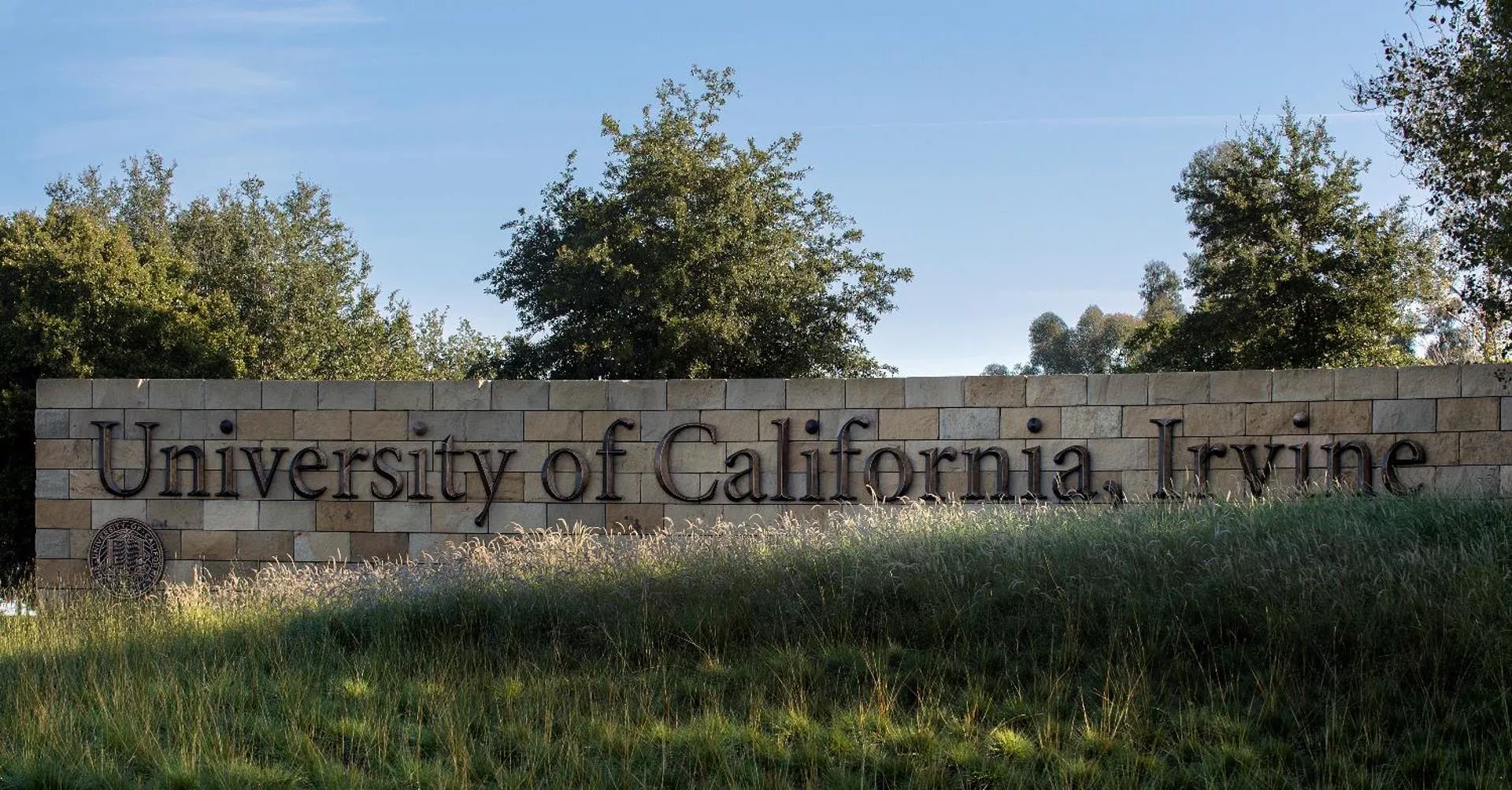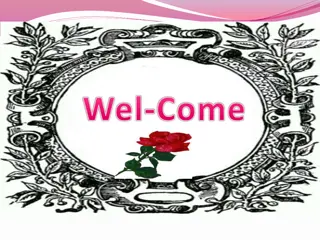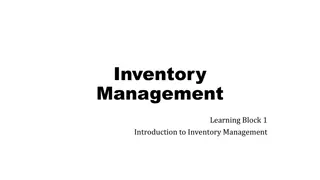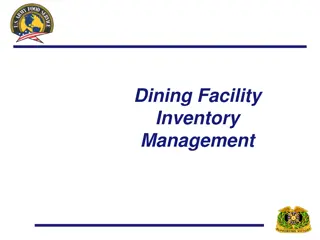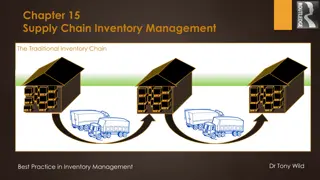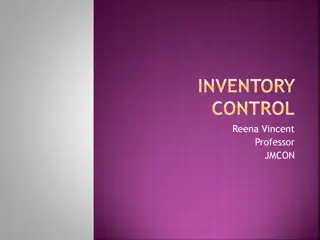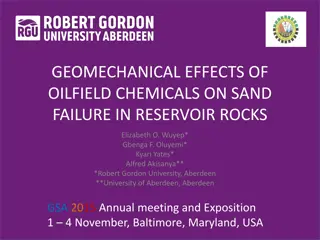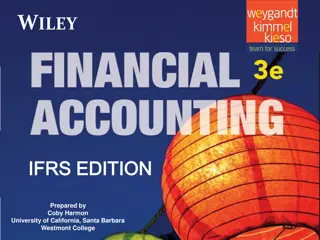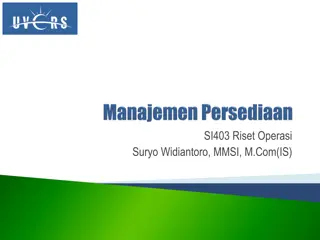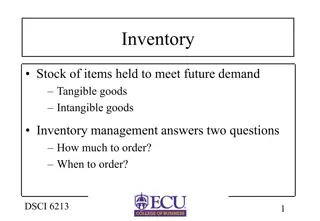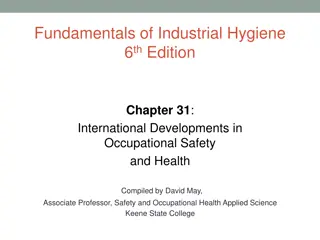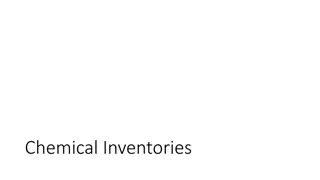Streamlining Chemical Inventory Management with UC Chemicals
This project plan focuses on transitioning existing chemical inventories into UC Chemicals system to address challenges with outdated information and database discrepancies. The UC Chemicals application offers real-time updates, assists first responders, and simplifies inventory reconciliation using RFID and QR code technology.
Download Presentation

Please find below an Image/Link to download the presentation.
The content on the website is provided AS IS for your information and personal use only. It may not be sold, licensed, or shared on other websites without obtaining consent from the author. Download presentation by click this link. If you encounter any issues during the download, it is possible that the publisher has removed the file from their server.
E N D
Presentation Transcript
Conversion and Transition to UC Chemicals Chemical Inventory System Overall Project Plan
Chemical Inventories: Problems and Solutions Problem with current state of chemical inventories: Chemical inventories are required to be updated regularly, and at least annually. UCI uses 3 different chemical inventory databases that creates difficulties when collecting data reports. Out-of-date information is problematic when determining allowable quantities of flammable chemicals or pyrophorics. Solution: Transition all existing chemical inventories contained in different databases into UC Chemicals, while providing an efficient and user-friendly chemical inventory system, allowing for real-time inventory updates Other benefit: Assist in providing first responders with accurate and up-to-date chemicals in affected spaces, allows review of current inventory before approving new chemicals to be purchased Project Goal: Fully transition all UCI units chemical inventories into UC Chemicals application 2
Benefits of Using UC Chemicals Updated inventory will provide real-time data in assisting with Maximum Allowable Quantities (MAQs) for limits of flammable chemicals volume in buildings control zones Accurate inventories prevent unnecessary duplications UC Chemicals application is easy to use on any device RFID tags and QR codes greatly reduce the time needed to complete and update inventory Chemical inventory reconciliation can occur quickly and easily 3
UC Chemicals Application and Tools Risk and Safety Solutions application: UC Chemicals: Chemicals (riskandsafety.com) Project supplies: iPads, carts, QR and RFID tags PPE (safety glasses, lab coats, gloves) 4
Container Labels EHS staff perform inventory by attaching labels to containers: QR codes Easy to identify chemicals in inventory; each container is scanned individually Allows labs to reconcile by sublocation so it is easier to find missing or misplaced containers and reports are more accurate RFID tags Allows for easy room location reconciliation using RFID scanner Rooms can be scanned quickly with a QR scanner and uploaded into a reconciliation report Freezer Tags Used in conjunction with QR and RFID tags for frost-covered containers 5
RFID Tag Technology and Features Risk and Safety Solutions RFID Tag Technology: https://youtu.be/llKkZQEVKVY Readable from 2 to 3 feet Small enough to affix directly to containers Must have QR barcode for location purposes Works on multiple types of containers and contents Solvent resistant laminate, double-sided 6
Types of Labels QR code tag Freezer Tag 7
Reconciliation and Maintenance Inventory maintenance: As labs purchase more chemicals, new containers should be added to inventory, and delete the empty containers that are being disposed. Chemical containers can be deleted using a mobile device by scanning the QR code Annual self-verification and attestation: UCI requires annual reconciliation of chemical inventories and labs must certify that their chemical inventory is up-to-date EHS-led lab safety inspections: Annual inspections look for chemical inventory reconciliation over the last year by comparing physical inventory to what is in UC Chemicals and the last time the inventory was certified 8
Responsibilities EHS: Assist with transition of chemical inventory to UC Chemicals Provide RFID labels, provide RFID scanners Run chemical inventory reports for MAQs of flammables, oxidizers, pyrophorics Researchers/Labs: Maintain chemical inventories in UC Chemicals when bringing in new chemicals or disposing chemicals Reconcile and self-certify chemical inventory annually 9
After the transition is completed: EHS provides the following instructions to labs: Chemical inventories must be updated when chemicals are used up and when new chemicals are brought into the lab. All chemicals and gases must be barcoded. Barcodes are available at these locations: https://www.ehs.uci.edu/enviro/haz-waste/pdfs/self-service- empty-container-locations.pdf Conduct a complete inventory reconciliation of your lab spaces at least once a year. RFID and QR scanners are available through EHS. Dispose of materials that are no longer useful, should be replaced, have deteriorated, or show container degradation. 10
Communication to Campus Research Laboratories Annual Email from Vice Chancellor of Research: message-from-pramod-khargonekar.pdf (uci.edu) Communication strategy Labs are provided a two-page instructional sheet on how to access UC Chemicals, add/delete chemicals and a link to the chemical inventory webpage with more resources. The lab is also provided barcodes for new chemicals. EHS Coordinator will send out an email with the instructional sheet and links to the chemical inventory webpage. It will also explain the labs responsibilities to keep the chemical inventory up to date. This includes 3 important steps: 1. adding new chemicals to UC Chemicals and assigning a barcode 2. deleting chemicals as they are used up or disposed of 3. reconciling their inventory annually (comparing physical inventory to the digital inventory in UC Chemicals) EHS inspectors will ask labs if they are doing the 3 steps mentioned above during the annual lab inspection. If they are not up to date, it will be a finding and the Coordinator will assist in getting them up to date. Coordinators will demonstrate how to use UC Chemicals and review the chemical inventory website during safety orientations. They will also discuss their responsibilities and what steps they need to take to maintain their chemical inventory. Communication to non-lab units: Student Affairs units Athletics Facilities Management School of the Arts 11
Two different approaches to transition inventory to UC Chemicals For researchers to transition inventory to UC Chemicals Method 1: Researchers to barcode own inventory Method 2: EHS to assist in barcoding inventory 13
Methodology Option 1 Option 1: Labs barcode their own inventory using QR codes and RFID tags Instructions are available at https://www.ehs.uci.edu/research- safety/chemical-safety/index.php Barcodes can be found at these locations: https://www.ehs.uci.edu/enviro/haz-waste/pdfs/self-service-empty- container-locations.pdf Pros: -Good for small labs, fewer chemical containers -PI or researchers don t want others touching containers Cons: Research staff not affixing labels correctly 14
Methodology Option 2 Option 2: EHS staff assist in barcoding the labs inventory EHS School Coordinators works with UC Chemicals Supervisor to schedule specific labs in their respective schools For efficiency, work is completed by building, and by floor, to minimize travel time and scheduling complications EHS School Coordinators assist Chemicals Supervisor by sending out the following message: To prepare for the transition, please ensure the following: At least one member of your lab is present at all times the students are working UC Chemicals is set up with all of your desired sublocations added into the system prior to the students arriving Login to chemical inventory https://app.riskandsafety.com/chemicals/, click on "Inventory Summary", then "Sublocations +" to add new locations or modify by clicking on the ellipse (...) Inform students of any special hazards or high hazard materials (e.g. highly toxic materials, pyrophorics, etc.). Remove all high hazard materials from any location the student is barcoding. 15
Option 2: EHS Staff conducts transition Student Employee Teams EHS staff go into labs in teams of 2 to 3 SME/Student Team Lead assigned to communicate with EHS project manager, report on status of supplies, and any issues with labs Students are trained on recognizing hazards, how to properly handle containers Bring up concerns to EHS SME/supervisor (Research Safety Manager) Data entry averages ~2 3 minutes per container Academic Year: about 10 students working at least 10-12 hours per week, up to 19 hours per week (desired) Summer (June through mid September): about 10 students working at least 30 hours per week, up to 40 hours per week (desired) Composition of student employees: Undergraduates and graduate students Work study, non-work study 16
Option 2: EHS assists with inventory 98% of chemical inventory transition work is performed via Option 2 Pros EHS staff completes chemical inventory for lab Cons EHS staff needed to perform inventory work EHS staff may miss chemical container locations 17
UC Chemicals Supervisor (Career staff) Responsibilities Interviews and hires students Provides training on tagging process Provides safety training on how to work safely and wear PPE Creates schedule for student teams Notifies academic school EHS School Coordinators to communicate schedule to individual labs and PIs Performs quality assurance of data input vs. actual chemical container information Creates monthly Chemicals scorecard 18
Container Labeling Conditions Students barcode chemicals and gases in standard storage locations (e.g. benchtops, flammable cabinets, corrosive cabinets, gas cabinets, chemical cabinets, etc.) Students do not barcode chemicals in special storage environments without assistance from the lab (e.g. gloveboxes, fridges, freezers, desiccators, controlled substance cabinets). The students do not barcode containers that are degraded, damaged, unreadable, etc. Damaged containers are disposed of through EHS. Note: If lab is performing their own barcoding of containers, they label all of their containers based on their knowledge of the hazards in the lab. 19
Additional Feature of UC Chemicals Store Front Function Software developer (RSS) is working with UCI to create functionality with Physical Sciences Stores (PS Stores) in order to capture incoming chemical containers to be entered into UCI Chemicals Tentative go-live for Store Front function: January 2023 20
Project Scorecard Metrics: Frequency: Monthly scorecard sent to EHS Executive Director Communication: Quarterly progress reported to VC Research and to campus wide Lab Safety Committee Anticipated overall project completion: June 2023 Month-by-month schedule Projected schedule vs. actual completion Number of labs and containers completed Number of labs remaining, by school Student Employee Hours Worked Budget spent and remaining 21


